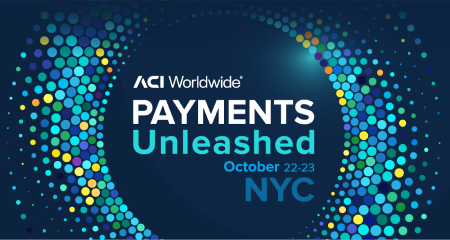- Solutions
- Banking
-
- ACI ConneticUnified cloud payments platform
- AcquiringDigital acceptance, merchant management
- IssuingDigital payments and accounts issuing
- Fraud managementReal-time enterprise fraud management
- RTGS / Wires and cross-borderMulti-bank, multi-currency processing
- Real-time, instant paymentsComplete real-time payments processing
- ATMsSelf-service, omnichannel digital experience
- Central infrastructureInnovative real-time payment infrastructure
- NEW Payment Hubs: Why Banks Must Move Forward With Urgency
-
- Merchant payments
- ACI Payments Orchestration PlatformEnable customer journeys across commerce channels, accept payments, prevent fraud and optimize your payments journey
- In-storeDynamic, modern in-store payments
- eCommerceOnline and mobile payments
- Alternative payment methodsGive more ways to pay
- Value-added servicesEngagement, optimization and reporting
- Fraud managementEnd-to-end fraud orchestration
- Risk, security, and complianceAchieve and maintain compliance
- NEW Datos names ACI Worldwide best-in-class in payments orchestration
- Industries we serve
- Billing and bill payments
- ACI SpeedpayDrive customer satisfaction with the widest range of bill pay options in the industry.
- Bill payment APIs and SDKsOutsource bill payment processing
- Fraud managementAI-based fraud orchestration technology
- Alternative payment methodsGive more ways to pay
- Loan servicingPreferred loan payment options
- Treasury managementStreamline and integrate your back office
- Automated debt collectionImprove your collections process
- Digital walletsManage digital cards and payments
- PCI compliance and securityAchieve and maintain PCI compliance
- Industries We Serve
- Fraud management and payments intelligence
- Fraud managementFraud solutions to minimize risk and prevent fraud
- Fraud management for bankingEnterprise-wide fraud prevention
- Anti-money launderingStay ahead of money-laundering schemes
- Robotic process automationAutomate payment processing operations
- Fraud management in the cloudProtecting your business in the cloud
- Fraud management for merchantsProtect payments from end to end
- ChargebacksPrevent chargebacks before they happen
- SCA complianceAchieve and maintain SCA compliance
- Digital identity solutionsConfirm identities with behavioral analytics
- NEW Scamscope fraud report: APP scam trends from around the globe
CompanyCustomersPartners
Home
On This Page
ISO 20022 is a messaging standard used across the financial industry.
In the domestic Real-Time Gross Settlement (RTGS)/Wire and cross-border payment spaces, transformation to the most recent ISO 20022 (HVPS+ and CBPR+) messaging standards has been ongoing since 2022. The North America Clearing House CHIPS wire system migrated in April 2024, and the U.S. Federal Reserve will update its Fedwire system in July 2025. It is important to note that everyone has been starting with an ISO 20022 standard.
Every rail — and type of rail — is somewhat unique, but overall, we’re seeing a tremendous synergy in the financial industry, profoundly reducing friction in getting a payment across the country, region, or globe using more than one payments network.
For example, when John Doe asks to debit me as many Australian dollars as possible to pay my daughter Jane Doe 100,000 British pounds using her IBAN account number at her bank in London, at least two payment networks — and potentially more than two banks — are required to get the payment there. Pre-ISO 20022, the payment could be delayed due to the inability to interpret some of the data and/or a bank requiring extra effort to convert the payment from one scheme to another using its legacy system(s).
ISO 20022 is all about everyone using the data within the transaction
The migration mandate for cross-border payments (Swift) and domestic RTGS/Wire spaces is just the first step, just as it was with global instant payment schemes, which began with ISO 20022, and the business rules they initially used when they started.
The ISO 20022 messaging standard is not just exponentially larger than almost every legacy format. It is an XML machine-friendly format for easier consumption by systems, helping to improve efficiency, reduce cost when natively used within the ecosystem, and reduce a tremendous amount of friction to get one payment across payment networks (Swift and CHAPS).
Enhanced data is becoming the norm
The financial industry is moving to the next level of ISO 20022 and beginning to use enhanced data, as many RTGS/Wire schemes and Swift have already migrated to ISO 20022, with fast followers just around the corner. We expect the industry will enforce this use of enhanced data more and more in 2025 and beyond.
Some examples of enhanced data are:
Structured remittance
Purchases, bills, and contracts are examples of structured remittance information. Think of someone sending a payment to a shipping dock to release goods within a container. The sender can send the embedded itemization of all the contents and amounts per type of goods within the payment. Further, instead of a person receiving the payment and manually reconciling the sub-amounts, the payment can go directly into the reconciliation system, allowing the money to be instantly verified and contents within the container released.
Category purpose code
A Category Purpose Code explains the reason for a payment so banks can understand the intent (business or personal) of the payment.
Legal identity identifier (LEI)
As defined by the Global Legal Entity Identifier Foundation, an LEI provides legal entity information:
- Official name
- Registered address
- Country of formation
- Codes for the representation of names of countries and their subdivisions
- Date of the first LEI assignment
- First establishment date
- Date of the last update of the LEI information
- Date of expiry, if applicable
The LEI allows a new level of identification per party within the payment — more relevant to corporate entities that don’t have bank clearing codes — as well as complimentary data about the financial institutions that have and use bank clearing codes to identify themselves.
Moving to using robust address information
Per the Payments Market Practice Group, the industry is moving away from the existing default/current practice of three lines of 35 characters to:
- A fully structured postal address is a preferred option.
- Semi-structured/hybrid postal address/hybrid format has the country and town provided in dedicated ISO 20022 data elements.
- Fully unstructured postal address (only to be available until November 2026) facilitates the transition and allows sufficient lead time for the corporate industry to structure the party address data.
Make use of the ultimate debtor and ultimate creditor within the payments
Using these two parties, for which other parties perform actions, is a value-add in ISO. The industry is moving to populate these parties with distinct party identifiers and robust addresses.
Conclusion
There is much more to ISO 20022, and although we are only in the infancy of making use of the data within the payments, we’re already beginning to realize the ease of getting a payment across rails. There’s more to follow – including getting payments to cross different types of rails.



